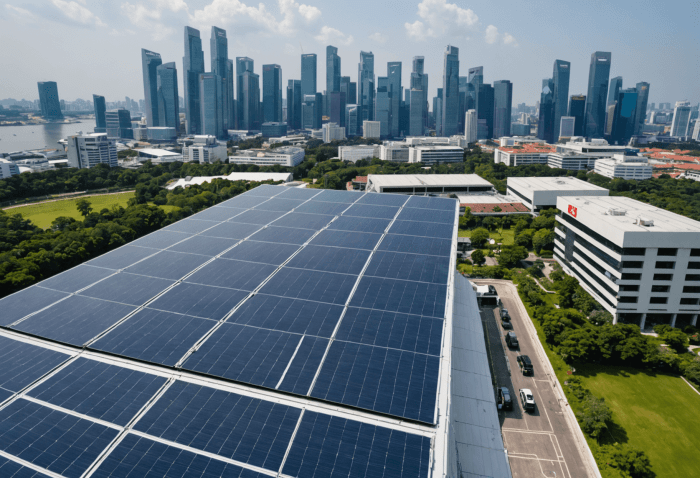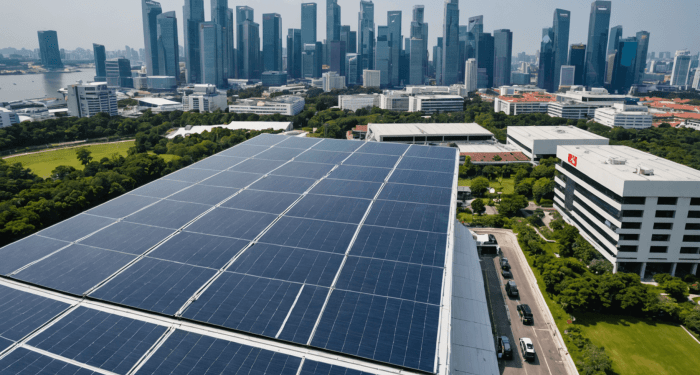Exploring the advancements in smart roofing technology, this article delves into the importance of integrating smart solutions in construction. From energy efficiency to sustainable practices, the future of roofing is evolving rapidly.
Importance of Smart Roofing Technology
Smart roofing technology plays a crucial role in the future of construction by revolutionizing how roofs function and interact with the environment. By incorporating smart technology into roofing systems, buildings can become more energy-efficient, sustainable, and cost-effective.
Key Benefits of Smart Roofing Technology
- Enhanced Energy Efficiency: Smart roofing technology can optimize energy consumption by regulating temperature control, reducing the need for excessive heating or cooling.
- Improved Durability: By monitoring and detecting issues in real-time, smart roofs can prevent potential damages and extend the lifespan of the roofing system.
- Increased Comfort: Smart roofing systems can adjust to weather conditions, ensuring a comfortable indoor environment for occupants throughout the year.
- Cost Savings: The energy efficiency and durability provided by smart roofs can lead to long-term cost savings on energy bills and maintenance expenses.
How Smart Roofing Technology Improves Energy Efficiency
Smart roofing technology utilizes sensors, actuators, and data analytics to optimize energy consumption in buildings. By dynamically adjusting insulation, ventilation, and lighting based on environmental conditions, smart roofs can significantly reduce energy waste and lower carbon footprints. This proactive approach not only benefits the environment but also contributes to creating sustainable and energy-efficient buildings for the future.
Current Trends in Smart Roofing
Smart roofing technology is rapidly evolving, offering innovative solutions that are transforming the roofing industry. Let's explore some of the current trends in smart roofing.
Innovative Smart Roofing Technologies
Smart roofing systems are incorporating advanced technologies to enhance performance and efficiency. Here are some examples of innovative smart roofing technologies available in the market:
- Solar Roof Tiles: These tiles are embedded with photovoltaic cells, allowing them to harness solar energy and convert it into electricity for powering homes.
- Green Roof Systems: These systems include vegetation and plant life on the roof surface, providing natural insulation, reducing energy costs, and improving air quality.
- Sensor-Integrated Roofing: Sensors are being integrated into roofing materials to monitor temperature, moisture levels, and structural integrity in real-time, allowing for proactive maintenance and early detection of issues.
IoT Revolutionizing the Roofing Industry
The Internet of Things (IoT) is playing a significant role in revolutionizing the roofing industry. By connecting roofing systems to the internet, IoT enables remote monitoring, data collection, and analysis, leading to predictive maintenance and optimized performance. This connectivity allows for better energy efficiency, cost savings, and improved sustainability.
Performance and Sustainability Comparison
When comparing traditional roofing systems with smart roofing systems, the advantages of smart technology become evident. Smart roofing systems offer higher performance levels through features like energy generation, temperature regulation, and real-time monitoring. Additionally, smart roofing systems contribute to sustainability by reducing energy consumption, lowering carbon footprints, and enhancing overall environmental impact.
Sustainable Practices in Smart Roofing

Smart roofing technology is not only about innovation and efficiency but also about sustainability. By incorporating eco-friendly materials and practices, smart roofing contributes significantly to sustainable building designs and helps reduce the overall carbon footprint of a structure
Eco-Friendly Materials and Practices
- Utilization of recycled materials such as reclaimed wood, metal, or rubber in roofing systems.
- Installation of solar panels on roofs to harness clean and renewable energy.
- Implementation of green roofs that are covered with vegetation to absorb carbon dioxide and reduce heat absorption.
- Use of cool roofs that reflect sunlight and heat away from the building, reducing the need for air conditioning.
Impact on Sustainable Building Designs
- Smart roofing technology helps in creating energy-efficient buildings that consume less electricity for heating and cooling.
- By reducing energy consumption, smart roofing contributes to lower greenhouse gas emissions, promoting environmental sustainability.
- The use of sustainable materials in smart roofing also helps in reducing waste and conserving natural resources.
Reduction of Carbon Footprint and Green Buildings
- Smart roofing plays a crucial role in reducing the carbon footprint of buildings by promoting energy efficiency and renewable energy generation.
- Green buildings with smart roofing systems not only benefit the environment but also provide healthier indoor spaces for occupants.
- The overall impact of smart roofing on green buildings is a more sustainable and eco-friendly approach to construction and design.
Integration of Solar Technology in Smart Roofing
Solar technology integration with smart roofing systems involves the installation of solar panels on the roof to harness the sun's energy and convert it into electricity. This combination allows for energy generation while also providing the benefits of smart roofing systems.
Solar-Powered Smart Roofing Solutions
- Solar shingles: These are designed to resemble traditional roofing materials but are equipped with solar cells to generate electricity.
- Solar roof tiles: Similar to solar shingles, these tiles can be seamlessly integrated into the roof while producing renewable energy.
- Solar roof membranes: These thin, flexible solar panels can be installed on various roof types, offering a discreet energy generation solution.
Benefits of Combining Solar Technology with Smart Roofing
- Energy efficiency: By harnessing solar power, smart roofing systems can help reduce reliance on traditional energy sources, leading to lower electricity bills.
- Sustainability: Solar technology is a renewable energy source, reducing the carbon footprint of buildings and promoting environmental conservation.
- Cost-effectiveness: Over time, the energy savings from solar-powered smart roofing solutions can offset the initial investment, providing long-term financial benefits.
- Increased property value: Buildings with solar technology integrated into their roofs are often more attractive to eco-conscious buyers, enhancing the property's resale value.
Conclusive Thoughts
In conclusion, the future of smart roofing technology holds immense potential for transforming the way we approach building design and energy efficiency. Embracing these innovations can lead to greener, more sustainable structures that benefit both the environment and building owners.
FAQ Summary
How does smart roofing technology improve energy efficiency?
Smart roofing technology can optimize energy consumption by regulating temperatures, reducing the need for excessive heating or cooling.
What are some examples of eco-friendly materials used in smart roofing?
Eco-friendly materials like recycled metal, cool roofs, and green roofs are commonly used in smart roofing systems.
How does the integration of solar technology benefit smart roofing systems?
Combining solar panels with smart roofing allows for energy generation and increased sustainability by harnessing renewable energy sources.














